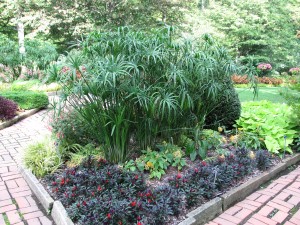Over thousands of years papyrus (Cyperus papyrus), aka Egyptian paper plant, was essential for food, medicine, fiber and shelter in ancient Egypt. Today, we utilize papyrus, as many other aquatic and bog-like plants, to add texture to the garden. Papyrus is classified as a non-hardy sedge (winter hardiness to USDA zone 9).
Invite this lovely exotic from the African continent into the summer garden or into a container on your patio or deck. It’s perfectly happy growing with its feet in water, and will prosper in garden soil under frequent drip irrigation. Papyrus grows at the edge of a water garden or ponds, in boggy soils, or in standing water in containers. Optimum growth is in full sun, but it tolerates partial shade. This incredibly fast grower will add 5 to 8 feet in a single season.
‘King Tut’ is a dwarf 4-5 feet tall cultivar. Its leafless green triangular stems stand tall and rigid at 2 to 3 feet high. Inadequate sunlight may compromise stem sturdiness. Roots are woody rhizomes which anchor the plant in a garden soil or container gravel medium. Papyrus does not suffer from serious insect or disease problems.
In the Southern Appalachian region (USDA zones 6 and 7), plants must be potted up and brought indoors before frost for winter care. Maintain at 40° F minimum temperatures and high humidity in a mostly sunny window, a sunroom, or a greenhouse.
Invite this beautiful Egyptian water plant into your garden. Garden centers often sell papyrus in their aquatic supply department or purchase from an e-commerce nursery on-line.


 Posted in
Posted in 
